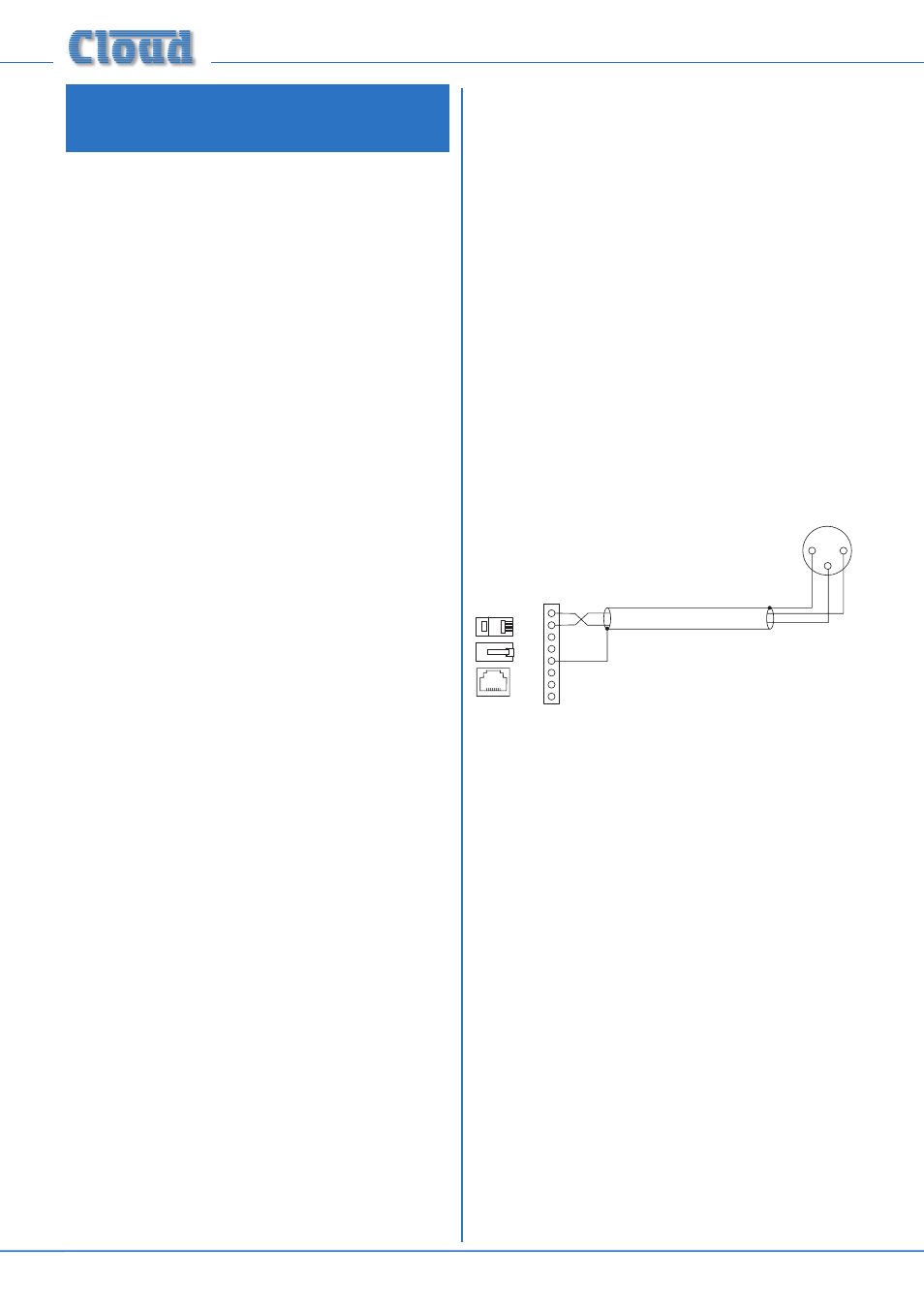Options and additional information, Lm-2 remote active module – general considerations, Control of music source and level via external dc – Cloud Electronics 46-120TMedia User Manual
Page 26: Connecting multiple lm-2s, In-zone sources, In-zone remote control, Using the facility port as an auxiliary zone input

46-120 Installation and User Guide V1.2
26
OPTIONS AND ADDITIONAL
INFORMATION
LM-2 remote active module – general
considerations
Cloud LM-2 remote input modules are available in three
form factors, to fit double-gang UK, American or German
DIN-standard electrical back boxes. Back boxes of either
the recessed type or surface-mounting type may be used,
providing they are at least 35 mm deep.
The modules should be connected to the
ZONE 1
FACILITY PORT using screened Cat 5 cable as described
at page 15.
The
OUTPUT connector on the module and
the
ZONE 1 FACILITY PORT on the mixer are both
screened RJ45 sockets.
Great care must be taken when connecting active input
modules; power is derived from the mixer and some wiring
errors may cause failure of the mixer. Please check all wiring
before testing the system.
Connecting multiple LM-2s
It may be desirable to connect local microphones or music
sources at more than one location in Zone 1 (which may be
a large function room, for example). LM-2 input modules may
be “daisy-chained” using their second
LINK RJ45 connectors
to achieve this.
Remember to consider the current drawn by any additional
input modules – see page 32 for details of current
consumption and PSU capability.
In-zone sources
An LM-2 module has an input for a dynamic microphone on
an XLR socket and a stereo line input on both two phono
sockets and a 3-pin 3.5 mm jack socket. The mic and line
inputs have separate level controls and all signals are mixed to
mono for routing to the 46-120.
If multiple LM-2s are “daisy-chained” as described above, the
mono sums from all modules are summed together.
The microphone input may be assigned priority over both
the line inputs and the music source selected for Zone 1 on
the 46-120 by pressing the module’s
MUSIC PRIORITY
button. See the LM-2 Installation Guide for full details of this
feature.
The Facility Port input circuitry includes a Noise Gate to
minimise residual noise when the microphone is not in use or
during gaps in music programme.
In-zone remote control
In addition to the mic and line inputs, LM-2 modules also have
controls for music level and music source selection; these
function in an identical manner to RSL-6 remote control
plates. No connection to the 46-120’s
MUSIC CONTROL
ports is required, all control is via the single screened
Cat 5 cable. However, for the remote controls to operate, it is
necessary to set the
MUSIC CONTROL SRC and/or LVL
buttons (as required) for Zone 1 to REMOTE.
If multiple LM-2s are “daisy-chained”, only one may have its
music controls operative; see the LM-2 Installation Guide for
full details.
Using the Facility Port as an auxiliary
zone input
The Facility Port provides a balanced audio input. If a port
is not connected to an LM-2 remote input module, it may
be used as a direct input to the zone from other equipment
forming part of the system (for example, a permanently
installed DJ mixer which only ever needs to feed its output to
that particular zone).
Wire an external balanced source to the facility port as
shown below:
1
8
7
6
5
4
3
2
1
3
2
BALANCED
OUTPUT (e.g. XLR)
hot (+)
hot
(+)
cold (-)
col
d
(-)
1
8
1
8
1
8
42-120 ZONE 1
FACILITY PORT (RJ45)
An unbalanced source may also be connected; the use of
balancing transformers is recommended.
RL-1 and RSL-6 Series remote
control plates – general
considerations
Cloud RL-1 Series and RSL-6 Series remote control plates
are available in three form factors, two fit single-gang UK or
American electrical back boxes respectively; the third is a
50 x 50 mm “Media” module, suitable for “Euro-module”
mounting frames available in most European countries. Back
boxes of either the recessed type or surface-mounting type
may be used, providing they are at least 25 mm deep.
The plates should be connected to the
MUSIC CONTROL
port of the relevant zone using single- or twin-core screened
cable as described at page 18. The plate terminations are
conventional screw terminals and the
MUSIC CONTROL
port on the mixer is a 3-pin 5 mm-pitch screw terminal connector.
The remote control plates are passive and thus do not draw
any current from the mixer.